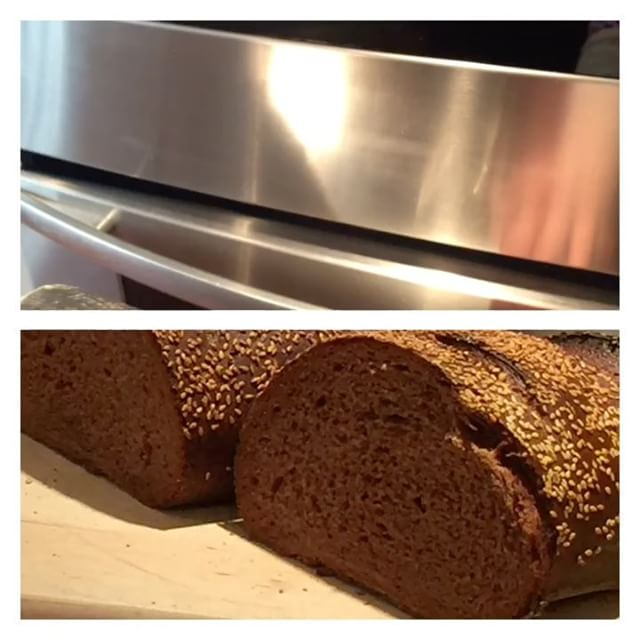
Dark, with a hauntingly savory-sweet flavor, these loaves are just delicious. I had such fun coming up with this recipe for “the perfect Pumpernickel bread” for the amazing Julia Child. Although some of the ingredients are unusual, as an ensemble, they work beautifully. The prune puree and yogurt are used strategically to keep these loaves extra moist and tender (and their taste is not detectable). For the most springy texture (a dough more a bouncy mouth-feel), substitute water for the yogurt. And don’t stop kneading until you feel real “resistance” at the center.
Speaking of kneading–although I make yeast breads by hand (which is a truly aerobic experience), you can also use a heavy-duty mixer, starting with the paddle attachment and then switching to the dough hook once the mixture starts to become glutinous. I do suggest, however, that you always finish any yeast dough by hand-kneading. That’s the only way to truly know if your dough has developed sufficient elasticity.
Any time I’ve suggested a tool, a piece of equipment, or a culinary term that’s unfamiliar to you, you can go to Learn to Cook for more information.
Brush an 8-quart bowl with melted butter and set aside to rise dough. Take out your pastry scraper, another large mixing bowl and a wooden spoon.
In a large mixing bowl, combine the yogurt, cubed butter, shortening, lekvar and molasses. Dissolve instant espresso in 1 cup boiling water and pour into a small, heavy-bottomed saucepan. Add broken chocolate and melt chocolate in espresso over very low heat until smooth, stirring frequently. Add to mixing bowl with powdered and whole caraway seeds and salt. Dissolve yeast in 1/2 cup warm water with a pinch of sugar until creamy and pour into mixing bowl along with the rye meal. Stir to combine well. Using a wooden spoon, briskly stir in enough bread flour, 1/2 to 1 cup at a time, until you create a mass that’s not easily stirred, but not dry. Turn the mass out onto a floured wooden board and knead until smooth and elastic, adding only as much flour as necessary to prevent dough from sticking to your work surface and hands. In the beginning of the kneading process, this dough will feel quite “pasty” because of the rye flour. As always, use a pastry scraper while kneading to scrape dough off the board cleanly as you continue to knead in a sufficient amount of flour.
When dough is smooth and elastic, place it in the buttered rising bowl. Cover bowl with buttered plastic wrap and a clean kitchen towel. Let rise in a draft-free spot until doubled in bulk, about 2 1/2 hours. Punch down dough with several swift swats from the back of your hand to deflate dough totally. Turn over dough, cover and let rise again for 1 1/2 hours.
Turn out fully risen dough onto a lightly floured board and use the blade of your pastry scraper to divide dough in half. Work with half the dough at a time, keeping the other half covered. Lay two clean kitchen towels on your counter and sprinkle them with bread flour. Roll dough half into a 7×10-inch rectangle. Starting at the short end farthest from you, roll dough toward you, pinching to seal as you go. Pinch to seal the ends and tuck under to attach to the bottom seam. Rotate and plump dough to finish shaping and place shaped loaf (seam side up) diagonally on a prepared towel. Form a sling by joining the corners of the towel farthest from the loaf. Secure the joined towel points within a closed drawer (in a quiet area) so the loaves hang undisturbed in their slings for 45 minutes.
While bread is rising, position the rack in the second or third lowest shelf in the oven and, if using a sheet of quarry tiles or a pizza stone, place it on the rack. On the rack below this, place a heavy-bottomed, oven-proof pan, which will preheat along with the tiles. Sprinkle a baker’s peel or a flat cookie sheet with cornmeal. Thirty minutes before the end of the rise, preheat oven to 450º F. If not using tiles or a stone, brush or spray 1 or 2 large (preferably dark steel) shallow baking sheets with vegetable oil and sprinkle interior with cornmeal. After mixing egg white and water, pour into a small medium-mesh sieve into another bowl to remove excess coagulation and any bubbles created while mixing. Place glaze next to your work surface.
Working with one loaf at a time, carefully release slings and gently turn out loaves from towels (smooth side up) onto the prepared baker’s peel or baking sheet at least 3 inches apart. Use your hands gently to plump loaf into a neat shape. Using a sharp serrated knife or a razor, slash tops of each loaf three times horizontally, going 1/3 inch deep into the dough. Using a pastry brush, paint tops and sides of loaves (excluding slashes) generously with glaze.
Just before inserting the dough into the hot oven, carefully pour ¾ cup warm water into the pan beneath the rack used to bake the loaves, then shut the door while you go get the loaves. If baking with tiles, insert the peel all the way to the back of the oven and with one swift jerk pull out the peel, leaving loaves on the hot tiles (preferably with three inches between them). If not using tiles or a stone, place loaves into the hot oven on their baking sheets as directed. Bake loaves at 450º F for 10 minutes. Reduce heat to 350º F and bake for 30 minutes. Remove from the oven and place on wire racks to cool thoroughly before slicing, 2 to 3 hours